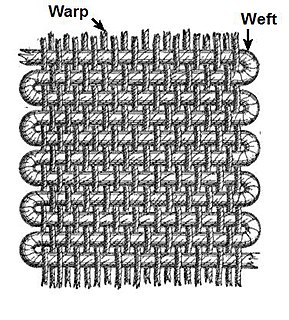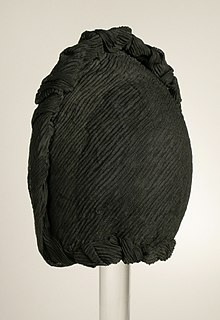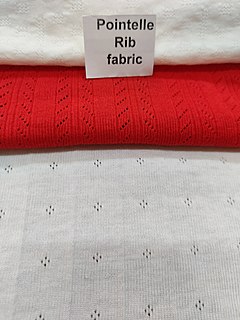Related Research Articles

Textile is an umbrella term that includes various fiber-based materials, including fibers, yarns, filaments, threads, different fabric types, etc. At first, the word "textiles" only referred to woven fabrics. However, weaving is not the only manufacturing method, and many other methods were later developed to form textile structures based on their intended use. Knitting and non-woven are other popular types of fabric manufacturing. In the contemporary world, textiles satisfy the material needs for versatile applications, from simple daily clothing to bulletproof jackets, spacesuits, and doctor's gowns.

Muslin is a cotton fabric of plain weave. It is made in a wide range of weights from delicate sheers to coarse sheeting. It gets its name from the city of Mosul, Iraq, where it was first manufactured. In the 17th and 18th centuries, Dacca, Bangladesh was regarded as producing the finest muslins.

A satin weave is a type of fabric weave that produces a characteristically glossy, smooth or lustrous material, typically with a glossy top surface and a dull back. It is one of three fundamental types of textile weaves alongside plain weave and twill weave.

Warp and weft are the two basic components used in weaving to turn thread or yarn into fabric. The lengthwise or longitudinal warp yarns are held stationary in tension on a frame or loom while the transverse weft is drawn through and inserted over and under the warp. A single thread of the weft crossing the warp is called a pick. Terms vary. Each individual warp thread in a fabric is called a warp end or end.

Flannel is a soft woven fabric, of various fineness. Flannel was originally made from carded wool or worsted yarn, but is now often made from either wool, cotton, or synthetic fiber. Flannel is commonly used to make tartan clothing, blankets, bed sheets, and sleepwear.

Gingham, also called Vichy check, is a medium-weight balanced plain-woven fabric typically with striped, check or plaid duotone patterns, in bright colour and in white made from dyed cotton or cotton-blend yarns. It is made of carded, medium or fine yarns.

Crêpe, also spelled crepe or crape is a silk, wool, or synthetic fiber fabric with a distinctively crisp and crimped appearance. The term "crape" typically refers to a form of the fabric associated specifically with mourning. Crêpe was also historically called "crespe" or "crisp".

Ninon is a lightweight, sheer fabric made with plain or leno weaving, it is a suitable material for curtains, evening wear and lingerie. Ninon is made with variety of filament yarns such as polyester, silk, rayon or nylon.

Toile is a textile fabric comparable to fine batiste with a cloth weave. Natural silk or chemical fiber filaments are usually used as materials. The word toile can refer to the fabric itself or to a test garment sewn from calico. The French term toile entered the English language around the 12th century, was used in the middle ages and meanwhile has disappeared.

A bolt is a piece of cloth woven on a loom or created by a knitting machine, as it is processed, stored and/or marketed. Consequently, its dimensions are highly variable – flexible and dependent upon the manufacturing, machinery, quantity, size, thickness and quality of the product. It is a unit used in manufacturing, transport and inventory. It is also used as a descriptor for wallpaper, which uses different fabrication machinery. Being encompassing, it is by its nature a generic and ambiguous term of convenience and context, used to describe fabric and wallpaper.

Pointelle is a knit fabric pattern with tiny holes typically in the shape of chevrons; the structure is geometric in shape and with repeated design similar to lace. It is a fine knit pattern with small open spaces, subtle stripe, and floral effects. The fabric is lightweight, airy, and of a very delicate nature. Pointelle is possible on warp knitting and weaving also.
Sussi or susi was a term for multicolored striped or checked cloth produced in the Indian subcontinent. Sussi was thin handloom fabric made of cotton, silk, or a blend of the two, with colored warp stripes. Punjab region was known for its production and exports during the Mughal period. Sussi was most often made with red and blue, blue and white, or green and white stripes, but other patterns were also produced. The fabric was exported to England, where sousaes were in great demand in the 18th century.
Huckaback fabric or Huck is a type of toweling cloth with a bird's eye or honeycomb pattern. It is a loosely woven fabric made of cotton or linen with Huckaback weave.
Salampore (salempore) was a kind of cotton cloth produced in India. It had been in use since the 17th century and was exported to Europe and Africa.
Barege (Barège) was a lightweight, sheer fabric matching a gauze. It was a union fabric made of silk and wool. Barege was a 19th-century fabric and originated from southwestern France. It takes its name from the town of Barèges but was mostly made in the town of Bagnères-de-Bigorre.
Prunella was an 18th-century worsted fabric also made with a blend of silk. It was produced in Norwich. Prunella was used in a variety of garments such as Petticoats, academic and barristers’ gowns, judges’ robes, coats, waistcoats, and shoes.
Toilinet (Tollanette) was a 19th-century combination fabric of wool and silk or cotton. It had a thick and soft construction. Toilinet was made with wool filling (weft) and a silk or cotton warp. Toilinet and Swansdown were often used for waistcoats.
Harateen (Harrateen) was woolen stuff of the 18th and early 19th-century produced in England. It was a furnishing material with a pattern used in Upholstery.
Diaper was a damask cloth with small patterns, mostly geometrical such as bird' eye or diamond-shaped.
Dorea was a type of striped or check patterned cloth made in the Indian subcontinent. The continued striped Dorea was a simplest form of Dorea.
References
- 1 2 3 Jerde, Judith (1992). Encyclopedia of textiles. Internet Archive. New York : Facts on File. p. 16. ISBN 978-0-8160-2105-5.
- ↑ "Definition of BAYADERE". www.merriam-webster.com. Retrieved 2021-05-26.
- ↑ Larousse, Éditions. "Définitions : bayadère - Dictionnaire de français Larousse". www.larousse.fr (in French). Retrieved 2021-05-26.
- 1 2 Tortora, Phyllis G.; Johnson, Ingrid (2013-09-17). The Fairchild Books Dictionary of Textiles. A&C Black. p. 50. ISBN 978-1-60901-535-0.
- ↑ d'industrie (Saint-Étienne), Musée d'art et; Besse, Nadine (2007). Esprit Staron: Rubans, soieries et haute-couture (in French). Somogy. p. 197. ISBN 978-2-7572-0128-2.


